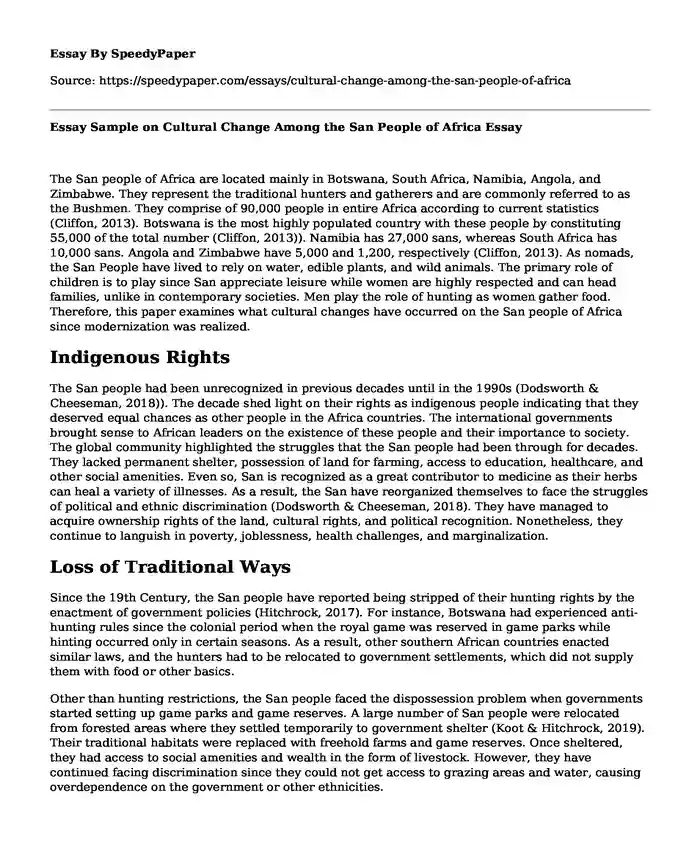
| Type of paper: | Essay |
| Categories: | Culture World Community Social change |
| Pages: | 3 |
| Wordcount: | 708 words |
The San people of Africa are located mainly in Botswana, South Africa, Namibia, Angola, and Zimbabwe. They represent the traditional hunters and gatherers and are commonly referred to as the Bushmen. They comprise of 90,000 people in entire Africa according to current statistics (Cliffon, 2013). Botswana is the most highly populated country with these people by constituting 55,000 of the total number (Cliffon, 2013)). Namibia has 27,000 sans, whereas South Africa has 10,000 sans. Angola and Zimbabwe have 5,000 and 1,200, respectively (Cliffon, 2013). As nomads, the San People have lived to rely on water, edible plants, and wild animals. The primary role of children is to play since San appreciate leisure while women are highly respected and can head families, unlike in contemporary societies. Men play the role of hunting as women gather food. Therefore, this paper examines what cultural changes have occurred on the San people of Africa since modernization was realized.
Indigenous Rights
The San people had been unrecognized in previous decades until in the 1990s (Dodsworth & Cheeseman, 2018)). The decade shed light on their rights as indigenous people indicating that they deserved equal chances as other people in the Africa countries. The international governments brought sense to African leaders on the existence of these people and their importance to society. The global community highlighted the struggles that the San people had been through for decades. They lacked permanent shelter, possession of land for farming, access to education, healthcare, and other social amenities. Even so, San is recognized as a great contributor to medicine as their herbs can heal a variety of illnesses. As a result, the San have reorganized themselves to face the struggles of political and ethnic discrimination (Dodsworth & Cheeseman, 2018). They have managed to acquire ownership rights of the land, cultural rights, and political recognition. Nonetheless, they continue to languish in poverty, joblessness, health challenges, and marginalization.
Loss of Traditional Ways
Since the 19th Century, the San people have reported being stripped of their hunting rights by the enactment of government policies (Hitchrock, 2017). For instance, Botswana had experienced anti-hunting rules since the colonial period when the royal game was reserved in game parks while hinting occurred only in certain seasons. As a result, other southern African countries enacted similar laws, and the hunters had to be relocated to government settlements, which did not supply them with food or other basics.
Other than hunting restrictions, the San people faced the dispossession problem when governments started setting up game parks and game reserves. A large number of San people were relocated from forested areas where they settled temporarily to government shelter (Koot & Hitchrock, 2019). Their traditional habitats were replaced with freehold farms and game reserves. Once sheltered, they had access to social amenities and wealth in the form of livestock. However, they have continued facing discrimination since they could not get access to grazing areas and water, causing overdependence on the government or other ethnicities.
Conclusively, there has been a lot of change in culture among the San people of Africa. In the 1920s, the population was 4,000, whereas currently, they are 90,000 (Sapignoli &Hitchrock, 2013). It implies that people now have time for families, unlike before, when they were busy with hunting and gathering. The San now have access to land ownership even though the poverty levels are still high. Also, previous ways of life that relied on hunting have been abolished following government rules on wildlife preservation. As a result, most Sans have ended up being reliant on government aid as they maximize the livestock awarded to them in Botswana.
References
Clifton, J. M. (2013). Dialects, Orthography, and Society. Work Papers of the Summer Institute of Linguistics, University of North Dakota Session, 53(1), 1. https://commons.und.edu/sil-work-papers/vol53/iss1/1/
Dodsworth, S., & Cheeseman, N. (2018). The potential and pitfalls of collaborating with Development organizations and policymakers in Africa. African Affairs, 117(466), 130-
145. https://academic.oup.com/afraf/article-abstract/117/466/130/4626916Hitchcock, R. K. (2017). Discontinuities in ethnographic time: A view from Africa. Journal of Anthropological Archaeology, 46, 12-27.
https://www.sciencedirect.com/science/article/pii/S0278416516301313
Koot, S., & Hitchcock, R. (2019). In the way: perpetuating land dispossession of the indigenous Hai//om and the collective action lawsuit for Etosha National Park and Magnetti West, Namibia. Nomadic Peoples, 23(1), 55-77.
https://www.ingentaconnect.com/content/whp/nomp/2019/00000023/00000001/art00004Sapignoli, M., & Hitchcock, R. K. (2013). A Chronology of the Central Kalahari Game Reserve: Update III, 2002–2012. Botswana Notes and Records, 45, 52-65.
https://www.jstor.org/stable/90024374
Cite this page
Essay Sample on Cultural Change Among the San People of Africa. (2023, Aug 10). Retrieved from https://speedypaper.net/essays/cultural-change-among-the-san-people-of-africa
Request Removal
If you are the original author of this essay and no longer wish to have it published on the SpeedyPaper website, please click below to request its removal:
- Free Essay Sample on Intercultural Intelligence
- Essay Example on Tourism and the Environment
- Free Essay: Effects of the Closure of Big Corporate Businesses on the Economy and Community
- Free Essay Answering Why You Need to Visit London Parliament at Least Once
- The Perfect Christmas Gift, Essay Example
- Essay Sample on Prevalence and Effects of White Privilege in Modern Day
- Essay Sample on Crisis of Liberal Democracy in Europe
Popular categories




